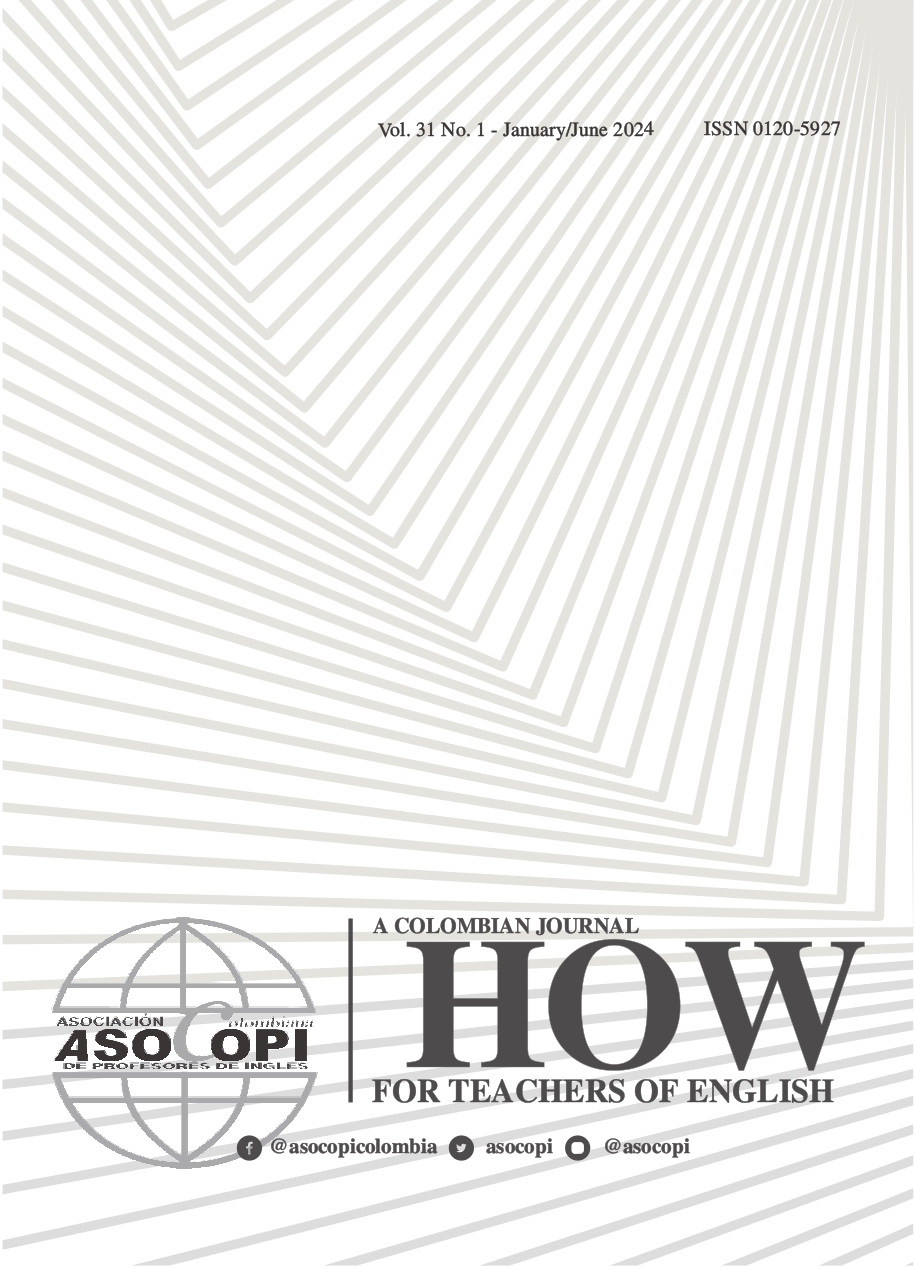Revised Bloom’s Taxonomy to Analyze the Scope of CLIL Classes with Children
Main Article Content
Abstract
This paper reports the results of a qualitative action research study conducted with children from a private Colombian institution. This study aimed to analyze the learners’ cognitive and knowledge outcomes measured according to the revised Bloom’s taxonomy once content and language integrated learning was implemented. Data were gathered through an interview with the learners’ parents, observation, and video recordings. Results give evidence that learners develop different processes simultaneously, classified by the mentioned taxonomy. This taxonomy is a helpful approach for English learners since it allows them to perform cognitive and knowledge processes without following rigid systematic learning. As a conclusion, this implementation with children allowed participants to develop cognitive processes with greater emphasis in levels 3 and 4 (apply and analyze), whereas level 2 (understand) was developed as part of the process. Meanwhile, the factual and conceptual knowledge dimensions were strengthened. Finally, procedural, and metacognitive knowledge is developed through the implementation itself.
Article Details

This work is licensed under a Creative Commons Attribution-NonCommercial-NoDerivatives 4.0 International License.

This work is licensed under a Creative Commons Attribution-NonCommercial-NoDerivatives 4.0 International License.
The authors of the manuscripts accepted for publication in HOW journal are required to sign a nonexclusive license agreement allowing ASOCOPI to reproduce the full text on the Internet or in any other available source. Authors retain copyright of their manuscripts with the following restrictions: first publication is granted to ASOCOPI; nonexclusive agreements with third parties can be established as long as the original publication in the HOW journal is properly acknowledged.
References
Alnsour, M. (2022). Using modified grounded theory for conducting systematic research study on sustainable project management field. MethodsX, 9, 1-19. https://doi.org/10.1016/j.mex.2022.101897
Amer, A., (2006). Reflections on Bloom's Revised Taxonomy. Electronic Journal of Research in Educational Psychology, 4(1), 213-230.
Anderson, C., McDougald, J., & Cuesta, L. (2015). CLIL for young learners. En C. Giannikas, L. McLaughlin, G. Fanning, & N. Muller, Children learning English: from research to practice (págs. 137-151). Garnet Education.
Aspers, P., & Corte, U. (2019). What is qualitative in qualitative research? Qualitative Sociology, 42, 139-160. https://doi.org/10.1007/s11133-019-9413-7
Attard, S., Walter, L., Theodorou, M., & Chrysanthou, K. (2016). Guía CLIL. Clil4U.
Bailey, A. (2017). What students are telling us: a case study on EFL needs and perceptions in the classroom? Íkala, Revista de Lenguaje y Cultura, 22(3), 501-516. https://doi.org/10.17533/udea.ikala.v22n03a08
Buendía, X., & Macías, D. (2019). The professional development of English language teachers in Colombia: a review of the literature. Colombian Applied Linguistics Journal, 21(1), 98-111. https://doi.org/10.14483/22487085.12966
Çelik, B., & Karaca, B. (2014). Improving learner outcomes in EFL: does early instruction lead to greater achievement? Novitas-ROYAL (Research on Youth and Language), 8(1), 1-10. https://files.eric.ed.gov/fulltext/EJ1167296.pdf
Chaves, O., & Hernández, F. (2013). EFL teaching methodological practices in Cali. Profile: Issues in Teachers Professional Development, 15(1), 61-80. https://revistas.unal.edu.co/index.php/profile/article/view/37862/40122
Clark, J., Porath, S., Thiele, J., & Jobe, M. (2020). Action research. New Prairie Press.
Congreso de la República de Colombia. (1994). Ley 115 del 8 de febrero de 1994. Diario Oficial N° 41.214 de 8 de febrero de 1994. [Por la cual se expide la Ley General de Educación.]. Bogotá. https://www.mineducacion.gov.co/1621/articles-85906_archivo_pdf.pdf
Dikmen, M. (2021). EFL learners' foreign language learning anxiety and language performance: a meta-analysis. International Journal of Contemporary Educational Research, 8(3), 206-222. https://doi.org/10.33200/ijcer.908048
Ekka, P. (2021). A review of observation method in data collection process. IJRTI International Journal for Research Trends and Innovation, 6(12), 17-19. https://www.ijrti.org/papers/IJRTI2112004.pdf
Forehand, M. (2005). Bloom's taxonomy: Original and revised. Emerging perspectives on learning, teaching, and technology, 8, 41-44.
Fry, M., Curtis, K., Considine, J., & Shaban, R. (2017). Using observation to collect data in emergency research. Australasian Emergency Nursing Journal, 20(1), 25-30. https://doi.org/10.1016/j.aenj.2017.01.001
García, S. (2015). Soft CLIL in infant education bilingual contexts in Spain. International Journal of Applied Linguistics, 1, 30-36.
Garzón, A. N. (2022). Raising cultural awareness in a CLIL class for Third Graders.. Recuperado de: http://hdl.handle.net/20.500.12209/17399
Gučec, V. (2019). CLIL: the advantages and disadvantages of implementation in the Croatian environment [Doctoral dissertation]. The University of Zagreb.
Haven, T., & van Grootel, D. (2019). Preregistering qualitative research. Accountability in Research, 26(3), 229-244. https://doi.org/10.1080/08989621.2019.1580147
Khamidovna, P. (2020). The mechanism of developing a culture of communication in students in the educational process. Journal of Critical Reviews, 7(12), 3096-3103.
Kostikova, L., Prishvina, V., Ilyushina, A., Fedotova, O., & Belogurov, A. (2018). Culture in teaching English as a foreign language. Advances in Social Science, Education and Humanities Research, 205, 13-17. https://doi.org/10.2991/iccese-18.2018.4
Krathwohl, D. (2002). A revision of Bloom's taxonomy: an overview. Theory into Practice, 41(4), 212-218. https://doi.org/10.1207/s15430421tip4104_2
Lasagabaster, D., & Sierra, J. (2010). Immersion and CLIL in English: more differences than similarities. ELT Journal, 63(4), 367-375. https://doi.org/10.1093/elt/ccp082
Le Gal, D. (2018). English language teaching in Colombia: A necessary paradigm shift. Matices en Lenguas Extranjeras(12), 156-190. https://doi.org/10.15446/male.n12.73267
Macías, F. (2010). Considering new perspectives in ELT in Colombia: from EFL to ELF. How. A Colombian Journal for Teachers of English, 17(1), 181-194. https://howjournalcolombia.org/index.php/how/article/view/72
Marsh, D. (2020). Using languages to learn and learning to use languages. CLIL.
Naghsh, M., Tahriri, A., & Zafarghandi, A. (2017). The relationship between classroom environment and EFL learners’ academic self-efficacy. International Journal of Education & Literacy Studies, 5(4), 16-23. https://doi.org/10.7575/aiac.ijels.v.5n.4p
Peng, S. (2019). A study of the differences between EFL and ESL for English classroom teaching in China. IRA International Journal of Education and Multidisciplinary Studies, 15(1), 32-35. https://doi.org/10.21013/jems.v15.n1.p4
Quimosing, A. B. (2022). Learning English as A Foreign Language (EFL): A Narratology. SALTeL Journal (Southeast Asia Language Teaching and Learning), 5 (2), 13-21.
Sobral, S. (2021). Bloom's taxonomy to improve teaching-learning in introduction to programming. International Journal of Information and Education Technology, 11 (3), 148-153. https://doi.org/10.18178/ijiet.2021.11.3.1504
Wildemuth, B. (2017). Applications of social research methods to questions in information and library science. Libraries Unlimited.
Wilson, L. (2016). Anderson and Krathwohl Bloom’s taxonomy revised. Understanding the new version of Bloom's taxonomy. Quincy College.





